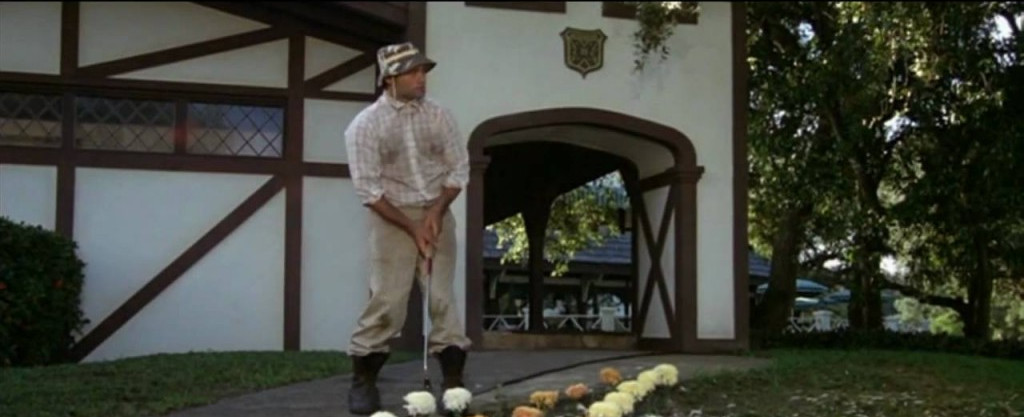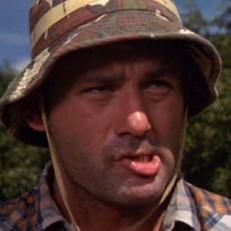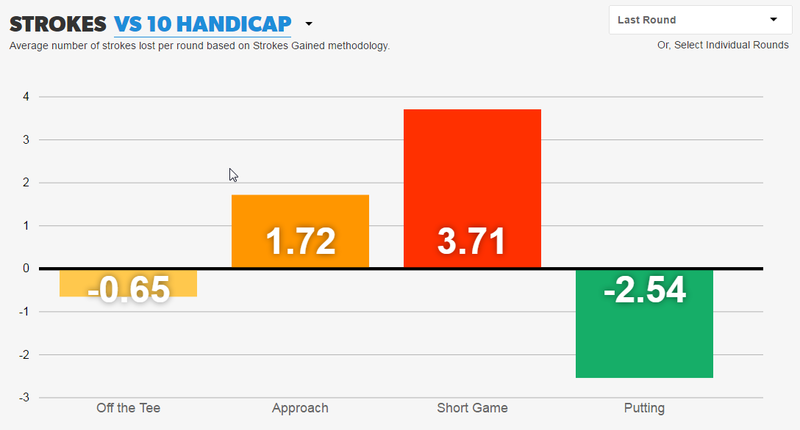Dissecting a Round
I’ve been looking for a quick way to analyze a round of golf to make sure that I am working on the right things. I looked at the LSW worksheet, but it was a bit more involved than I care for. I just want a quick way to analyze a round to see where I am leaking strokes. Here is a summary of the round I played yesterday.
- Split the fairway with the driver although not exceptionally long and played a PW to pin high. Missed the birdie putt from about 10’ and tapped in for par.
- Pulled driver left into hazard. Dropped and played LW to green and 2 putted for bogey.
- Hit driver high and only got 177. Pushed a 4i into the trees right and punched onto the green and 2 putted. A tree was blocking me, so I had to play for the front of the green with a back pin.
- 8i on par 3 came up short. Pitched on and 2 putted.
- Crushed a high draw with my driver 285 yards and played a PW to the green. Missed birdie and tapped in for par.
- I hit my driver a bit right (didn’t draw) and ended up behind trees. I had to punch to the left side of the FW. I hit my SW fat followed by a chunky 8i chip. 2 putt and walked away with a double.
- I hit a decent drive into the wind (238) followed by a decent 3w (high fade) to short of the green. A chunky SW pitch put me on the fringe where I 2 putted for par. The area in front of this green is usually very soggy and tough to pitch from.
- Pushed a 7i long and it plugged in the fringe. Lift, clean, place and played a short chip and 2 putted.
- Decent drive, but it didn’t roll out very much. I laid up with a 4i since there is a pond guarding the front of the green. I pitched on and 2 putted for par.
- Pulled my drive left and short (186 that may have hit a tree and came back) and then blocked a 6i into the hazard right of the green. Dropped, pitched on and almost holed it to save par, but made the bogey putt.
- Decent drive (225) followed by an excellent PW and made the birdie putt.
- Hit a decent 3w on to the front of the green and 2 putted for par.
- I hit a really good drive, but it only went about 200 yards. There was some mud on the ball, so I think it pretty much sat down close to where it landed. 8i came up short. Perhaps the wind was stronger than it felt. Pitched on with SW and made the par putt.
- Little pull with the 8i into bunker. Played an excellent shot out to the left of the hole. The spin on the ball made it roll to the right though and ended up about 6’ away. Missed the par putt short and tapped in.
- This is where things get ugly. I hit a horrible 3w with a ton of top spin that only went 110. I pulled a PW really bad that dropped out of a tree and landed just behind a tree root. I was able to get the club on it before it clanked into the root, but ended up thinning it across the green. From there I thinned another back past the hole and 2 putted for a triple.
- Hit a 9i short and right. Pitched on and 2 putted.
- Hit another horrible 3w short and right. I punched a soft 5i iron under a low hanging branch that landed short of the green and looked like it was going to roll to the hole very nicely, but kept rolling to the back fringe. I then bladed a SW to the other side of the green and bladed another SW back past the hole. Another 2 putt for triple.
- Pushed my driver to the right a little and had to hit another punch to keep it under tree branches. Punch shot pulled behind a bunker, but I finally got one up and down for par.
I came up with a quick way to look at the execution of this round on a hole by hole basis. I broke each hole down to Drive, Approach, Short Game, and Putting. To me, driving is only on par 4 or 5 holes where I am teeing off with a driver or 3 wood. Par 3 holes I considered approach shots, but I could go either way. For each hole, I would add or subtract strokes in each area where I felt that area cost me a stroke or if I gained a stroke. The end score on each hole would be equivalent to my score in relation to par. For instance, if I bogeyed the hole, I would add a stroke for the area that caused me bogey it. If I birdied it (at least I got 1), then I would credit the area that contributed most. Sometimes it was a half a stroke in two different areas. In the end, I tallied it all up to see where I lost the most strokes. Here is what I ended up with.

On hole number 1, I hit the FW and followed it up with a GIR and easy par. On 2, I drove the ball into the hazard which cost me a stroke. If I had gotten up and down for par, I could have put a -1 in one of the other categories where I made up for it. The fourth hole cost me a stroke in the approach shot since I missed the green pretty short. Hole 5 is interesting. I hit a REALLY good drive, so I credited driving a half stroke. I scored par on the hole so I took away that half stroke in putting since it was a makeable first putt. This was kind of a judgement call, but I felt that my exceptional drive set me up for an easy PW on a longer hole. The approach was good, but not outstanding. On the next hole, my drive was right and blocked by some trees, but it wasn’t horrible. My punch recovery shot was decent. It was really a fat pitch and chunky chip that led to double, so I debited short game 1.5 strokes. The drive certainly set up the scenario that I had to deal with, but I didn’t capitalize on a decent recovery which is why I only charged my driver with a half stroke. At any rate, you get the picture. Different people can see these differently, but I hope over time, it will reveal trends that I can combine with Game Golf.
At the end of the day, my driving cost me 2.5 strokes, approach shots 7, and short game 4.5. My putting only cost me a half stroke that I made up on another hole for 0 net strokes lost. My approach shots cost me the most in total although my only birdie was attributed to a good approach. My driving only cost me 2.5 strokes, but my short game cost me 4.5. It would have been 6.5 if short game shots didn’t save me a half stroke on 4 holes. Another interesting fact is that all holes where I scored double bogey or worse were ones where I had more than 1 stroke lost in short game strokes. On one hand, I could say that the missed approach is what really lead to the lost short game strokes, but I tried to treat each shot on its own merit. Bad approach shots are going to happen, but compounding them by adding 1 or more strokes with a very easy skill is very harmful since short game shots are not nearly as difficult.
I went Game Golf to see what it had to say. Here is a link to the round. It seems to agree that my short game could use some work followed by my approach shots.
I am interested to see what everyone thinks about the system I used to analyze the round or how I scored myself against it. I am also interested to hear thoughts on where I can best shave some strokes. This was only one round, but it is very typical for me.









22 Comments
Recommended Comments
Create an account or sign in to comment
You need to be a member in order to leave a comment
Create an account
Sign up for a new account in our community. It's easy!
Register a new accountSign in
Already have an account? Sign in here.
Sign In Now